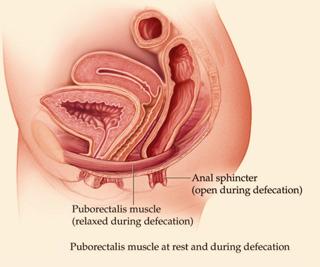
Anismus, also known as pelvic floor hypertonicity, anal sphincter dysserynergia, dyssynergic defecation, and paradoxal puborectalis dysfunction, is a disorder of the external anal sphincter and puborectalis muscles (one of the pelvic floor muscles) upon attempted bowel movement. It is a form of pelvic floor muscle dysfunction. Upon defecation, the pelvic floor muscles should normally relax to allow for evacuation of stool. With anismus, the puborectalis muscle and anal sphincter contract causing the stool to not be able to pass through the anal opening to properly evacuate. This can be painful and can lead to obstructive constipation. Other complications can be fecal impaction and an enlargement of the diameter of the rectum called megarectum. Those with anismus chronically bear down or strain in attempt to have a bowel movement and further irritate the pelvic floor muscles. Medical evaluation may include a rectal digital exam, evacuation proctography, balloon expulsion test, and dynamic imaging studies. Medical treatment may include Botox injections into the puborectalis muscles and surgical resection.
How can Pamela Morrison Physical Therapy, PC help anismus?
One of the expert pelvic therapists at Pamela Morrison Physical Therapy will perform a complete history and physical exam. Close inspection of your pelvic alignment and pelvic floor muscles and sphincter will occur. Pelvic nerve tests will also occur. It would be determined if the puborectalis and other pelvic floor muscles and anal sphincter were in spasm and unable to relax also known as pelvic floor muscle hypertonicity. Surface EMG biofeedback of the pelvic floor muscles would assist the therapist in determining the severity of the spasm or hypertonicity and if normal relaxation of the pelvic floor muscles is possible. This is essential for resolving anismus. Physical therapy treatment at our practice for anismus would consist of realignment of the pelvic girdle via manual techniques, soft tissue mobilization of the pelvic girdle and pelvic floor muscles, stretching exercises, visceral manipulation, neuromuscular re-education of the pelvic floor muscles, surface EMG biofeedback training, therapeutic exercises, and a home exercise program. Surface EMG biofeedback for hypertonicity focuses on down-training the pelvic floor muscles. Down-training helps to lower the resting tone of the pelvic floor muscles and teaches you how to relax the pelvic floor muscles and anal sphincter for effective bowel evacuation. The manual therapies and modalities such as electrical stimulation help to eliminate the muscle pain and spasm. The use of rectal dilator therapy may also prove beneficial. Proper toilet posture and bowel evacuation techniques will be taught. Our practice has very successful outcomes treating anismus.


